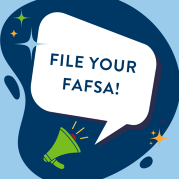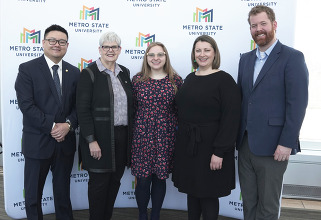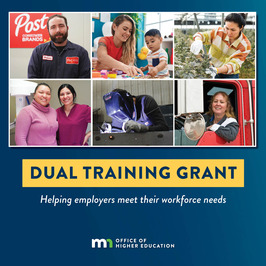|
Students planning to attend college or trade school this fall are still encouraged to complete the FAFSA or Minnesota Dream Act now

To date, the U.S. Department of Education (US DOE) has processed more than 6 million Free Applications for Federal Student Aid (FAFSA) forms nationally, and the backlog of sending electronic FAFSA filing records to schools and state agencies is now caught up. Going forward, schools and state agencies should receive student records within 1-3 business days after the application is submitted by students.
The filing records will allow schools to begin packaging financial aid offers to students. US DOE continues to encourage schools, states, and scholarship organizations to provide flexibility and as much time as possible for students to make important enrollment decisions, as financial aid offer letters will be given to students at a much later date than typical years. Students are encouraged to check with their institutions of interest as aid application and commitment deadlines may have shifted.
As a reminder to students and families, it is not too late to file the 2024-2025 FAFSA or Minnesota Dream Act Application to receive financial aid for the 2024-25 academic year. There are many financial aid opportunities at the federal, state and school level to help pay for college or trade school this fall.
The Office of Higher Education Financial Aid staff can assist with general application or process questions. If you have any questions or concerns, please contact 651-642-0567. Select option 2. The line is answered Monday - Friday from 8:00 a.m. - 4:30 p.m.
|

Office of Higher Education Commissioner Dennis Olson visited Bemidji State University (BSU) on Feb. 27 to discuss two new game-changing financial aid programs, the American Indian Scholars Program and North Star Promise Scholarship, both new programs established during the 2023 legislative session.
As part of his spring listening tour, Commissioner Olson highlighted the programs at BSU's American Indian Resource Center, hearing directly from students, staff and stakeholders about the impact that these financial aid programs will have on higher education opportunities. (Photo courtesy of Bemidji State University)
|

Student loan borrowers who are feeling stressed about repaying their student loans now have an advocate in their corner. Minnesota’s law provides consumers protections in the Student Loan Borrower Bill of Rights and an advocate on their side with the Student Loan Advocate at the Minnesota Department of Commerce.
In October 2023, student loan borrowers were required to resume repayments on their student loans, following three years of student loan repayments being suspended. While the federal government is the lender for most student loans, the loan repayments are managed by loan servicers, which are for-profit businesses. Dealing with student loan servicers can be challenging, and the Minnesota Department of Commerce can help.
The Student Loan Borrower Bill of Rights, which became law in 2021, gives Minnesotan borrowers consumer protections under the law, with “do’s and don’ts” that loan service providers must follow. The Student Loan Advocate program offers education, advocacy, and information for borrowers having challenges with loan servicers in how to manage loan repayments.
On March 28, the Department of Commerce held a press event to promote consumer protections in the Student Loan Borrower Bill of Rights and address the student loan debt crisis. Pictured above are Sen. Tou Xiong, Metro State President Ginny Arthur, student representative Emma Gabbert, Commerce Commissioner Grace Arnold, and Rep. Zack Stephenson. (Photo courtesy of Minnesota Department of Commerce)
Resources:
|
Nearly 3,000 Minnesotans have received on-the-job training through grant

The application period for the 2024 Dual Training Grant is open for employers in the industries of advanced manufacturing, agriculture, health care services, information technology, child care, transportation, and legal cannabis industry occupations. To date, 2,992 Minnesotans have earned credentials through Dual Training Grant funded programs.
Approximately $5 million in Dual Training Grants is available for grants to employers throughout the state this year. Grant funds are used to support the related instruction component of a dual-training program. The dual-training model pairs on-the-job training with formal related instruction to create a robust learning environment – resulting in skilled employees, also known as dual trainees, and an enhanced company culture. New for 2024, employers can apply for up to $15,000 (or 10% of the requested grant amount) for dual trainee support costs like transportation, tutoring, and translation.
Resources:
|
The U.S. Department of Education will conduct a one-time adjustment this summer, but you may need to take steps to qualify

Many student loan borrowers with federal loans have an opportunity to receive full student cancellation or more credit towards cancellation through a U.S. Department of
Education one-time payment count adjustment, but they must act before April 30, 2024.
Most federally held student loans will receive an automatic adjustment, but borrowers with these types of loans must consolidate first to maximize their benefit:
- Commercially managed Federal Family Education Loan (FFEL),
- Parent PLUS,
- Perkins loans, and
- Health Education Assistance Loan (HEAL) Program loans.
Resources:
|

A new report shows that the state’s Direct Admissions program is having an impact on increasing in-state enrollment and Free Application for Federal Student Aid (FAFSA) filing rates for Minnesota high school graduates. According to the data, for students participating in Direct Admissions, 50 percent enrolled in a Minnesota college or university and 77 percent completed the FAFSA. When looking at high school students who did not participate in Direct Admissions, only 26 percent enrolled in an in-state institution and 51 percent completed the FAFSA.
The report provides insights into the first pilot year of the program, with nearly 2,000 students at 36 high schools participating. In addition to increased in-state enrollment and higher FAFSA filing rates, the report also shows equitable outcomes when disaggregated by gender, race and ethnicity, and eligibility for free or reduced-price meals.
Currently, 119 state high schools and 55 Minnesota colleges and universities are participating in Direct Admissions. High schools interested in joining the program during the 2024-25 school year are invited to learn more.
|
In consultation with the Spinal Cord Injury and Traumatic Brain Injury Advisory Council, the Minnesota Office of Higher Education is currently accepting proposals for the Spinal Cord Injury and Traumatic Brain Injury Annual Research Grant.
The overall objective of this program is to foster and encourage innovative research for that leads to a cure, novel treatments, and/or rehabilitative techniques for spinal cord and traumatic brain injuries. Interested applicants must submit a Letter of Intent by April 24 and proposals will be accepted until May 22.

|
